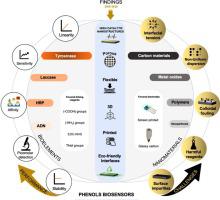Colloids and Surfaces B: Biointerfaces ( IF 5.8 ) Pub Date : 2020-08-25 , DOI: 10.1016/j.colsurfb.2020.111344 Amira Bensana 1 , Fethi Achi 2

|
Electrochemical biointerfaces are constructed with a wide range of nanomaterials and conducting polymers that strongly affect the analytical performance of biosensors. The analysis of progress toward electrochemical sensing platforms offers opportunities to provide devices for commercial use. The investigation of different methods for the synthesis of phenol biointerfaces leads to design challenges in the field of monitoring phenolic compounds. This paper review the innovative strategies and feature techniques in the construction of phenolic compound biosensors. The focus was made on the preparation methods of nanostructures and nanomaterials design for catalytic improvements of sensing interfaces. The paper also provides a comprehensive overview in the field of enzyme immobilization approaches at solid supports and technical formation of polymer nanocomposites, as well as applications of hybrid organic-inorganic nanocomposites in phenolic biosensors. This review also highlights the recent progress in the electrochemical detection of phenolic compounds and summarizes analytical performance parameters including sensitivity, storage stability, limit of detection, linear range, and Michaelis–Menten kinetic analysis. It also emphasizes advances from the past decade including technical challenges for the construction of suitable biointerfaces for monitoring phenolic compounds.
中文翻译:

功能性纳米结构生物界面用于感测酚类化合物的分析性能。
电化学生物界面由多种纳米材料和导电聚合物构成,这些材料会严重影响生物传感器的分析性能。对电化学传感平台进展的分析提供了提供用于商业用途的设备的机会。对用于合成酚生物界面的不同方法的研究导致了在监测酚类化合物领域的设计挑战。本文综述了酚类化合物生物传感器的创新策略和特色技术。重点是纳米结构的制备方法和纳米材料的设计,以促进传感界面的催化改进。本文还对固相支持物上的酶固定方法和聚合物纳米复合材料的技术形成以及混合有机-无机纳米复合材料在酚醛生物传感器中的应用提供了全面的概述。这篇综述还重点介绍了酚类化合物电化学检测的最新进展,并总结了分析性能参数,包括灵敏度,储存稳定性,检测限,线性范围和米利斯-门腾动力学分析。它还强调了过去十年的进展,包括在构建用于监测酚类化合物的合适生物界面方面的技术挑战。这篇综述还着重介绍了酚类化合物电化学检测的最新进展,并总结了分析性能参数,包括灵敏度,储存稳定性,检测限,线性范围和米利斯-门腾动力学分析。它还强调了过去十年的进展,包括在构建用于监测酚类化合物的合适生物界面方面的技术挑战。这篇综述还重点介绍了酚类化合物电化学检测的最新进展,并总结了分析性能参数,包括灵敏度,储存稳定性,检测限,线性范围和米利斯-门腾动力学分析。它还强调了过去十年的进展,包括在构建用于监测酚类化合物的合适生物界面方面的技术挑战。



























 京公网安备 11010802027423号
京公网安备 11010802027423号